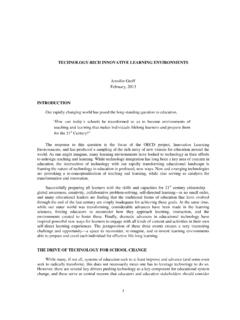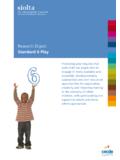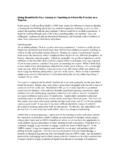Transcription of e-Learning Theories in Practice: A Comparison of …
1 e-Learning Theories in Practice: A Comparison of three Methods Felix M dritscher Institute for Information Systems and Computer Media (IICM) Graz University of Technology, and Campus02, University of Applied Sciences Degree Program in IT and IT-Marketing, Graz, Austria and Abstract: As e-Learning and distance learning tend to get more and more important for all kind of organisations, researchers and practitioners are becoming aware of the fact that a simple technology-focussed approach does not guarantee successful teaching and learning . Thus, a shift to pedagogy-based initiatives can be observed within the field of e-Learning . This paper examines the implications of commonly known learning Theories on online courses.
2 Therefore, a case study was carried out within the field of adult education aiming at the implementation of different e-Learning strategies with respect to the behaviouristic, cognitive, and constructivistic school of learning . Furthermore, these instructional approaches are compared with each other in order to examine aspects such as the effort for the teacher and the students, the effectiveness of each method, the students workload or collaborative and social aspects of e-Learning . Keywords: e-Learning ; learning Theories ; behaviourism; cognitivism; constructivism; case study, Moodle. Categories: , , , , , 1 Introduction e-Learning is identified as one of the emerging areas as shown by means of concrete numbers in [Brennan 2003] and has turned out to be important for educational institutions as well as for companies as highlighted by concrete application scenarios in [Dietinger 2003].
3 Nevertheless, various problematic aspects such as higher costs and political influences [Noble 2001], the focusing on technology and the negligence of pedagogical principles [Park et al. 1987], usability problems of e-Learning systems, etc. were reported. According to [Gunawardena & McIsaac 2004], a shift from technology- to pedagogy-based research can be observed within the field of distance learning . Educators have become more interested in examining pedagogical themes and strategies within online courses instead of experimenting with new technologies. Against this background, the need for realising distance learning phases was recognised at the Campus02, University of Applied Sciences, Graz, Austria [Campus02 2005].
4 Thus, an internal project which aimed to support lecturers with implementing their distance learning strategy was initiated. The study dealt with in this paper is one result of this project s outcomes and was initiated in order to examine and compare different e-Learning methods. Therefore, three online courses were implemented with the intention to follow the ideas of commonly known learning Theories summarised in section 2. Afterwards, a detailed description of the e-Learning study, the didactical strategy and the implemented courses is given in section 3. J. of Universal Science and Technology of learning , vol.
5 0, no. 0 (2006), 3-18 Appeared: 28/5/06 , the three methods are compared to each other and findings are pointed out in section 4. As this paper discusses different approaches for realising online courses, the following assumptions about didactical aspects of e-Learning were made by the author: It is possible to implement an e-Learning course on a certain topic in different ways, and each of these methods is realisable in the area of adult education. e-Learning courses implementing different pedagogical strategies may vary in the preparation, implementation, or concluding stage. The behaviouristic and the constructivistic approach may not be that effective and popular due to the disadvantages of these two learning Theories .
6 Group tasks may be more effective and popular than tasks for individuals. With respect to [Oblinger & Hawkins 2005], the term e-Learning is currently used for different educational scenarios in literature. Therefore, at this point, the term has to be defined by describing the character of the case study: The study deals with the scenario of running three online courses entirely virtually over a period of two month. Each course aims at mediating a set of competencies given by objectives, materials, and instructions. All interactions between the learners (students) and the instructor (teacher) are accomplished online utilising an e-Learning system.
7 The three courses differ with respect to instructional design, which means that each course is determined by another set of tasks. The learning objectives as well as the learning content are equal for each course. 2 e-Learning Theories Implementing e-Learning courses can be seen as a complex process going beyond systematically executing steps within an instructional design model. Among a large number of critical aspects, [McLeod 2003] suggests instructors to consider principles of learning by means of historically grown learning Theories . Thus, it is possible to reuse certain procedures, for instance pre-defined instructional components as stated in [Merrill 2001].
8 Within the e-Learning situation, three learning Theories the Behaviourism, the Cognitivism, and the Constructivism are of importance as shown in [Cooper 1993], [Dietinger 2003], In the following, these three Theories are described in short, and implications for realising online courses are derived. Behaviourism The behaviourist school of thought, influenced by researchers like Watson, Thorndike, Pavlov, and Skinner who postulates that learning is a chance in observable behaviour caused by external stimuli in environment [Skinner 1974]. Behaviourists see the mind as a black box , in the sense that a response to a stimulus can be observed quantitatively, totally ignoring the effect of thought processes occurring in mind.
9 [Atkins 1993] highlights four aspects relevant for realising online courses with respect to the behaviourist school: 4 Moedritscher F.: e-Learning Theories in Practice .. The learning material should be broken down into small instructional steps being presented in a deductive way by means of starting with a rule, category, principle, formula or definition, giving positive examples to reinforce understanding, and showing negative examples to establish conceptual boundaries; Course designers have to define sequences of instructions using conditional or unconditional branching to other instructional units and pre-determining choices within the course.
10 Normally, activities are sequenced for increasing difficulty or complexity. The sequence and pacing through the materials are usually beyond learner control; To maximise learning efficiency, learners may be routed to miss or repeat certain sections based on the performance on diagnostic tests, or on tests within the sequence of learning activities. Nevertheless, the instructional designer may also allow a learner to choose the next instruction out of a set of activities, giving the learner more control over the learning process; The behaviouristic approach for learning suggests to demonstrate the required operation, procedure or skill, and to break it down into its parts with appropriate explanation before learners are expected to copy the desired behaviour.








